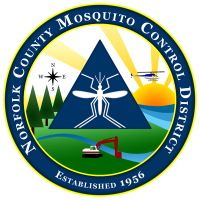Walpole, MA 02081
Office: (781) 762-3681
Office hours: Monday-Friday 7:00AM to 3:30PM
David A. Lawson, Director
NCMCD Commission
The Norfolk County Mosquito Control District Commission represents the interests of the member communities and their residents by providing oversight of NCMCD activities. The Commissioners each live or work within a community serviced by the NCMCD, were nominated by municipal authorities, and were evaluated and appointed to their posts by the State Reclamation and Mosquito Control Board. The Commission strives to ensure that the member communities receive services consistent with applicable laws and justified by tenets of public health, vector control, environmental safety and fiscal responsibility. The Commission invites input and questions from community officials and residents.
NCMCD Commission Meeting Minutes and the Current Agenda
Annual Town Report & the Annual Operations Report
A Brief History of Mosquito Control and How the Norfolk County Mosquito Control District Came To Be
Mosquitoes have plagued humanity for as long as humans have been around. No one has ever liked getting bitten by mosquitoes, but the connection between mosquito bites and the misery and untold numbers of human deaths from mosquito borne disease was not understood until modern times. In his 2019 book, Timothy Winegard reveals estimates that mosquitoes have killed more people than any other single cause—fifty-two billion of us, nearly half of all 108 billion humans who have ever lived1. This is an astounding thought.
In 1896-97 Sir Ronald Ross proved that malaria was transmitted by the bite of a mosquito 2. In 1900-1901 Charles Finlay and Walter Reed proved that yellow fever was transmitted by the bite of a mosquito3. These discoveries mark the impetus for and the advent of modern mosquito control. Since mosquitoes need standing water to complete their life cycle, the logical response in any effort to reduce mosquito borne disease would be to eliminate standing water. The most famous early application of this principle was the mosquito control efforts of William Gorgas that allowed the United States to complete construction of the Panama Canal in 1914, where the French had previously failed due in large part to extreme casualties of their workers from yellow fever and malaria.
Malaria was a problem in Massachusetts up until the late 1800’s. Soon after the turn of the century, some towns in the Commonwealth implemented mosquito control programs based on the new found knowledge about mosquitoes and their connection to disease. As early as 1901, the town of Brookline was conducting water management to reduce standing water, and was oiling standing water to kill mosquito larvae. It may be the earliest organized effort at mosquito control in the state.
In the United States, New Jersey became the first state to create state level mosquito control commissions in 1912 and began extensive ditching of salt marshes for the control of salt marsh mosquitoes based on this new found understanding of removing the water sources for mosquitoes.4
In Massachusetts, a state drainage board was created in 1918 for the purpose of ascertaining
“…what lands, if any, in the Commonwealth may advantageously be drained for agricultural and industrial uses, the protection of the public health, the utilization of deposits therein, or for other reasons.”
This board existed until 1923 when it was renamed the State Reclamation Board and continued in this mission. In 1929, the first explicit mosquito control legislation in the state was enacted when chapter 288 (The ‘Mosquito Amendment’) amended the reclamation law (MGL Chapter 252). The State Reclamation Board then transitioned from the work of wetland reclamation primarily accomplished for the benefit of agriculture and industry, to work explicitly accomplished for mosquito control as well.
Both the Cape Cod Mosquito Control Project and the Nantucket Mosquito Control Project were begun in the spring of 1930. The Belmont-Cambridge-Watertown Mosquito Control Project began in December, 1930, and the Natick Mosquito Control Project in July, 1931. These ‘locally funded’ districts set the stage for other mosquito control districts to form in subsequent years, especially after the depression and World War II.
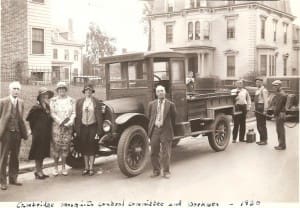 Early mosquito control efforts in Cambridge, MA, 1930. (Photo, courtesy of the East Middlesex Mosquito Control Project)
Early mosquito control efforts in Cambridge, MA, 1930. (Photo, courtesy of the East Middlesex Mosquito Control Project)
As the Great Depression began, both federal and state money was expended in ways to employ those who were out of work. In 1931, four state funded mosquito control projects were started under the provisions of chapter 112 of the Acts of 1931 with the express intent of alleviating unemployment. The following statement from the 1931 fiscal year report of the State Reclamation Board makes clear how the goals of mosquito control and relief of unemployment would, together, become the driving force for mosquito control in the ensuing years of the depression.
“In the four state projects employment was given to a total of 1,372 citizens of the Commonwealth, during the fiscal year 1931, all from the ranks of the unemployed, and, in practically every instance, to men with a large number of dependents. Thus in addition to successful work in controlling mosquito breeding areas along the seacoast of the Commonwealth, a very creditable result was obtained in relieving distress among groups of unemployed, many of whom would otherwise have required assistance from welfare boards or private charities.”
Covering part of Norfolk County, the South Shore Project was constituted in 1931 while three other state funded projects were constituted in other coastal areas of the Commonwealth. This South Shore Project consisted of all the towns between Quincy and Plymouth inclusive. Since ditching of wetlands was considered the key way to control mosquitoes, large amounts of money and manpower were applied to ditching wetlands, especially the salt marshes of the Commonwealth. From 1930 – 1934 the Reclamation Board oversaw the ditching of over 3,000 miles in wetlands, primarily the salt marshes of 51 coastal communities.5
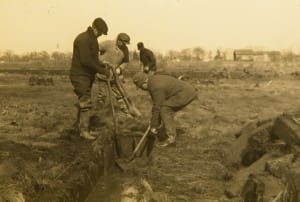
Workers digging ditches on salt marshes in the 1930’s (Photo courtesy CT DEEP WHAMM Program)
Apparently Massachusetts was ahead of the curve in regard to combining relief of unemployment with mosquito control ditching efforts, as the following quote reveals.
“In April 1933, Fred Bishopp, chief of USDA’s Division of Insects Affecting Man and Animals since 1926, offered a glimmer of hope to the struggling New Jersey [mosquito control commissions].
“It seems to me,” Bishopp declared in a speech in Atlantic City, “that the great public benefits to be derived from anti-mosquito operations and the excellent opportunity which it gives for utilizing large numbers of the unemployed cannot be too strongly emphasized.” Bishopp singled out Massachusetts as an example of how other states and the federal government could use mosquito control to provide jobs for unemployed.”” 6
In addition to these state funded projects, for which state funding was reduced after 1934, Federal WPA and CWA projects then completed additional mosquito control work up until the end of the decade, and both state and federal funds were allocated for the maintenance of these ditches.
In the 1930’s,
“As the Soil Conservation Districts gradually took over improvement of wetlands for agricultural purposes, and private interests began to improve similar areas for industrial sites, the [Reclamation] Board’s activities became centered around drainage for the improvement of comfort and health.” 7
In other words primarily for mosquito control, though the State Reclamation Board did oversee smaller projects to control midges and noxious weeds, and eventually was involved in control of greenhead flies as well, which continues to this day under the oversight of a couple of the Mosquito Control Districts.
Up until the end of WWII, insecticide resources were sparsely used, and most resources were applied to ditching. The application of a light fuel oil to water surfaces, called ‘oiling’, was utilized to control mosquitoes where standing water could not be removed. References to the use of pyrethrum appear to show that it was not widely used. In the 1930’s, for every $1,000 spent on ditching, only one penny was spent on larviciding!
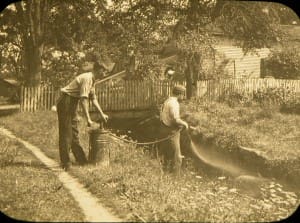
Workers ‘oiling’ standing water to control mosquitoes – unknown date. (Photo courtesy of CT DEEP WHAMM Program)
After the creation of DDT in WWII, this product was seen as a major solution to mosquito control problems and became widely used for all kinds of mosquito control, in addition to its widespread use in agriculture.
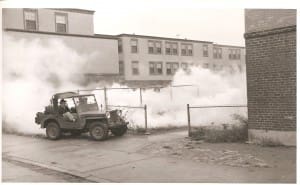
DDT fogging in 1954 (photo courtesy of the East Middlesex Mosquito Control Project)
After World War ll, organized mosquito control began to expand in the state. The following quote from the 1961-1962 report of the State Reclamation Board reveals the rationale for how organized mosquito control would thereafter develop in the Commonwealth.
“The early local projects were of inestimable value in that they demonstrated the relative ineffectiveness of small isolated controlled areas, open to mosquito migrations from their entire periphery – in contrast to the Cape Cod Project which included the entire contiguous towns located on the Cape. Experience with these two types of projects had a definite effect upon the mosquito control outlook following the encephalitis outbreak in 1938, the malaria scare associated with the return of veterans at the close of World War II, and the gradual movement of people from the city proper to the urban sections over the past decades. Fortunately, the increased demand for mosquito control coincided with an accumulation of convincing data to show the more desirable features offered by projects set up on a county level. The advantages were numerous both from the financial and physical standpoints, as illustrated by the experience, over two decades, with the Cape Cod Project operations. A favorable reception of the county project idea resulted in the establishment of the Berkshire County Mosquito Control Project in 1945, the Norfolk County Project in 1956, the Plymouth County Project in 1957 and the Bristol County Project in 1958, all patterned, in general, after the Cape Cod Project. All are authorized by special legislation and financed by annual mosquito control assessments levied on the taxpayers of the respective Counties.”8
Also of significance, the original Belmont-Cambridge-Watertown district, which by 1945 had dwindled to only the town of Belmont, then became part of the newly formed East Middlesex Mosquito Control District.
As noted in the quote above, increased demand for mosquito control was driven by people moving out of the cities to where mosquitoes were more prevalent and from renewed concern over disease, particularly after severe outbreaks in Massachusetts of Eastern Equine Encephalitis (EEE) in 1938-1939 (35 human cases and 25 deaths, plus 300 horse deaths) and in 1955-1956 (16 human cases and 9 deaths). It is worth noting that the very first EEE isolated from a human being was in Weymouth in 1938 at South Shore Hospital. In 1953, Quincy and the nearby coastal towns of Braintree, Weymouth, Hingham, Hull, and Cohasset formed the South Shore Mosquito Control Project (later expanded to include Scituate, Marshfield and Duxbury). This is not to be confused with the earlier state funded South Shore Project that existed from 1931 to 1934. In 1956, special legislation formed the Norfolk County Mosquito Control Project (originally 22 towns).
During the 1960’s, what we now call the environmental movement began and brought scrutiny to mosquito control practices, primarily driven by concern from the over use of pesticides. The EPA at the federal level, and the Pesticide Board at the Commonwealth level began taking a critical look at pesticide use. The 1960’s also saw Massachusetts become the first state in the country to pass wetland protection laws in recognition of the important values of wetlands. In response to all this, mosquito control began its transition to the more modern science-based operation it is today. Mosquito ditching was reduced, to where today the NCMCD maintains ditches in current existence but generally does not create new ditches unless in special permitted situations. The NCMCD endeavors to work with a broad array of groups in the work of wetland restoration, where restoration can function concurrently to control mosquitoes. Modern larvicides are targeted specifically at mosquitoes with extremely low non-target effects, and adult mosquito control products are put out at incredibly low rates with very low risk to the public and environment.
In 1980, the South Shore Mosquito Control Project (originally formed in 1953) was disbanded and the towns of Quincy, Braintree, and Weymouth soon joined the Norfolk County Mosquito Control District. In conjunction with the arrival of West Nile Virus into the Commonwealth, the Town of Milton re-joined the Project in 2001, having withdrawn in 1981. Since 2001, the Norfolk County Mosquito Control District has been comprised of its current 25 towns. [The Norfolk County Towns of Wellesley, Brookline and Cohasset belong to other Mosquito Control Districts. Note that the Mosquito Control Districts in Massachusetts with ‘County’ titles are not actually County agencies.]
Since the turn of the century, there has been an increase in the yearly prevalence of Eastern Equine Encephalitis (EEE), a rare but deadly mosquito-borne disease. This, combined with the annual risk from West Nile Virus, has brought mosquito control more visibly into the public’s consciousness, and made ongoing mosquito control a high priority in the Commonwealth. Three state run aerial sprays in 2006, 2010, and 2012 over large swaths of the southeastern part of the state to combat EEE, even more extensive sprays in 2019 over southeastern areas and in the Metro-west part of the state in response to probably the worst EEE outbreak in the state since 1938. In 2024, another outbreak of EEE led to aerial spraying across the southeastern part of the state as well as ground spraying in areas outside of established mosquito districts in central parts of the state. The renewal of the Nantucket and Martha’s Vineyard Districts, and the creation of the Pioneer Valley Mosquito Control District in 2017 speak to this increased awareness. Within the 25 towns of the NCMCD, residential demand for mosquito control has increased 4-5 fold since the year 2000.
Emerging diseases such as Chikungunya and Zika virus and the resurgence of more well know diseases like Dengue into the United States, will require the continuing efforts of public health and mosquito control agencies across the country and around the world.
The Norfolk County Mosquito Control District operates under the principles of Integrated Pest Management (IPM), utilizing surveillance, source reduction, larviciding and adult control methods to provide the best control while minimizing harm to people and the environment.
References
1The Mosquito: A Human History of Our Deadliest Predator by Timothy C. Winegard 2019
2 The History of Malaria, an Ancient Disease, http://www.cdc.gov/malaria/about/history/
3 Yellow Fever and The Reed Commission, http://exhibits.hsl.virginia.edu/yellowfever/mosquitoes/
4 John B. Smith Chronology, http://vectorbio.rutgers.edu/jb-smith-chronology.php
5 The Mosquito in Massachusetts with Suggestions for Control of Breeding Areas, Robert Wales, B.S., 1939, pg. 4.
6 The Mosquito Crusades: A History of the American Anti-Mosquito Movement, From the Reed Commission to the First Earth Day. Gordon Patterson, 2009, pg. 126.
7 State Reclamation Board, Annual Report, 1955-1956, in Commonwealth of Massachusetts Annual Report of the Department of Agriculture, fiscal year 1956.
8 State Reclamation Board, Annual Report, 1961-1962, in Commonwealth of Massachusetts Annual Report of the Department of Agriculture, fiscal year 1962.
Contact the Director
NOTE: Please do not use this form to make requests for mosquito treatments. Those requests can be made here
